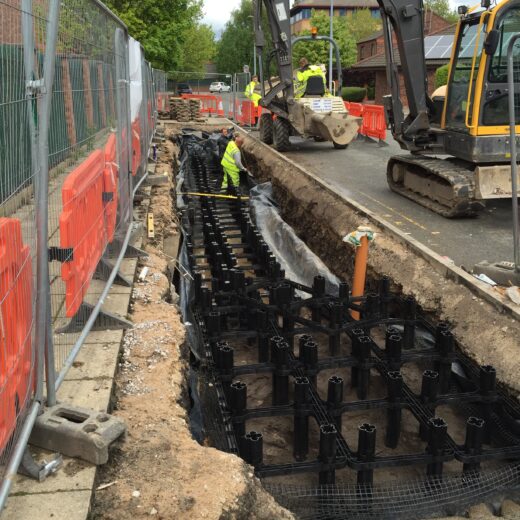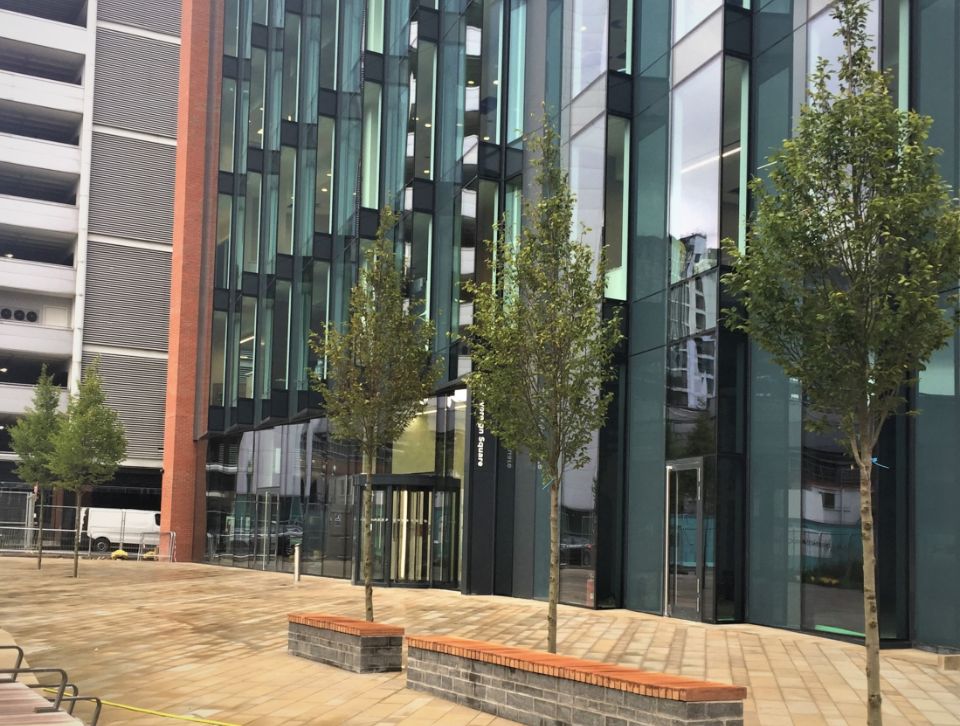
Average soil volume per tree: 15 m3 (533 ft3)
Number of Trees: 3
Tree Species: London Plane
Total Silva Cells: 160 frames, 60 decks
Installation Date: June 2015
Installation type: Integrated – Trees and Stormwater
Project Site: Streetscape
Project Designer: City of Trees Manchester
Developers/Contractors: City of Trees Manchester/Landscape Engineering

City of Trees Manchester (formerly Red Rose Forest) is an environmental charity working to transform Greater Manchester into “a greener, healthier and more satisfying place to live work and invest.” When Pete Stringer, Special Projects Manager for City of Trees Manchester wanted to deliver a tree-planting project that could demonstrate and quantify how trees could help to managing surface water runoff and improve water quality, he was looking for someone with expertise in this field and contacted DeepRoot about getting involved.
City of Trees Manchester, in partnership with the University of Manchester, wanted to assess how trees and soil under paving could be used as a form of ultra-urban “green infrastructure” to improve water quality and reduce the amount of runoff directed into the sewer. The selected site for the project site is a pavement in a residential area in Salford near Manchester. This was a challenging environment on a site where trees had previously failed and had to be removed.
City of Trees Manchester installed three trees in a 3-layer Silva Cell system filled with a bioretention soil provided by British Sugar. Water enters the system using slot kerbs, which convey it from around a 50 square meter catchment area into a distribution pipe under the paving, where it is then distributed evenly throughout the whole system. An underdrain sits at the bottom of the system to convey excess water away. Monitoring chambers at either end were installed to make collecting water samples easy, and data collection began as soon as the last of the monitoring equipment was installed. Manchester University is responsible for supervising the data collection; the idea is to involve university students and pupils from the local secondary school, the Oasis Academy to help analyse the data over the coming years.
The project has been funded by Salford City Council, the Environment Agency and United Utilities, who are all keen to explore real life natural solutions for tackling localized flooding and diffuse pollution, the latter being a key requirement of the European Water Framework Directive. This project would set an important precedent with regards to the management of surface water, and City of Trees Manchester hopes that the data will provide a compelling argument that trees and soils are a viable alternative to engineered drainage systems in future iterations of the Local Development Framework.

Pete Stringer is full of enthusiasm for the preliminary results and surprised and impressed with the clarity of the water exiting the system from the first rainfall event. “The aim of the Howard Street project is to demonstrate and quantify how, in an urban context, Green Infrastructure such as street trees can provide a natural solution to managing surface water runoff and addressing diffuse pollution,” he said. “City of Trees Manchester had long been aware of the projects that had been delivered in North America using DeepRoot Silva Cells for helping managing water quality and quantity and was keen to demonstrate this system in a UK setting.”
Tony Hothersall, Director of City of Trees Manchester, recently used the Howard Street project in a presentation about future proofing Manchester, using the details from this site to demonstrate some forward thinking and innovative tree planting design. City of Trees Manchester, the Environment Agency, Salford City Council, United Utilities and Urban Vision plan to share their findings in videos, conferences, and more.
The first of those is a video produced by City of Trees Manchester about the installation that explains why the Silva Cells are being used and demonstrates how trees and soils, carefully designed and planted, can be used as tools to manage surface water and non-point source pollution. It includes perspectives from the Environment Agency, United Utilities, Salford City Council, University of Manchester, City of Trees Manchester, and DeepRoot.
The Salford City Council Development Plan Document (Publication Core Strategy, February 2012) includes a section on “Green infrastructure spatial strategy” that states that a network of green infrastructure will be established throughout the city to, among other things, mitigate the risks and impacts of flooding and air, water, and noise pollution, as well as provide attractive walking routes. We believe Howard Street is one of the first and essential steps toward that goal.
